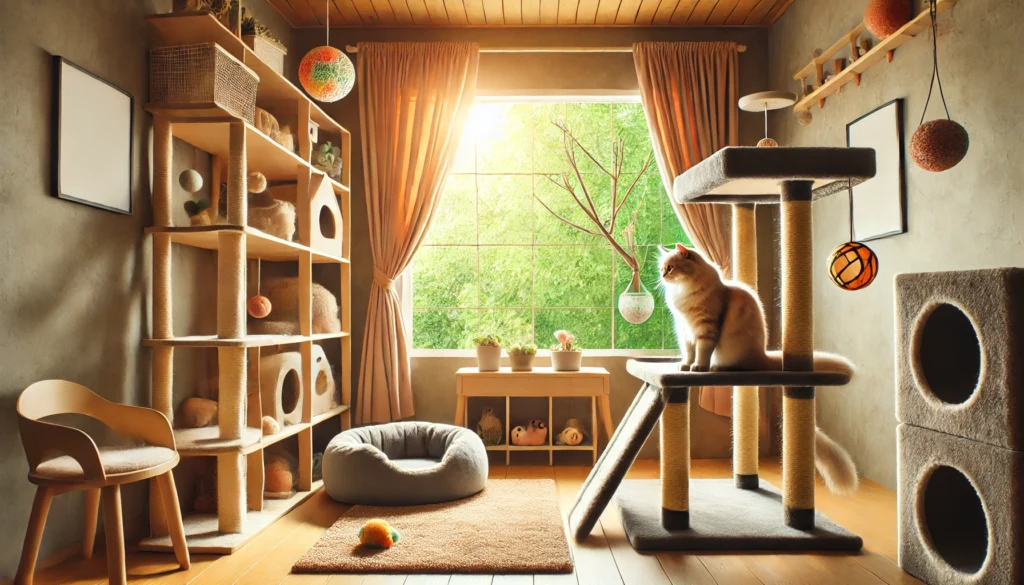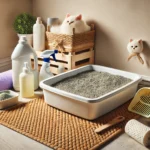Cats are highly intelligent animals with natural instincts that include hunting, climbing, scratching, and exploring. In an indoor environment, these instincts can sometimes be stifled, leading to boredom or stress. Environmental enrichment is key to providing a stimulating and fulfilling life for your cat. This article explores various ways to enrich your cat’s environment and encourage their natural behaviours.
Why Environmental Enrichment is Important for Cats
Environmental enrichment is essential for indoor cats because it provides mental stimulation, encourages physical activity, and helps reduce stress. Without adequate enrichment, cats may develop behavioural issues like over-grooming, aggression, or lethargy. By providing outlets for their instincts, you can improve their overall well-being and prevent potential health issues.
Recognising Natural Feline Behaviours
Understanding your cat’s innate behaviours is the first step to providing effective enrichment. Here are some common behaviours to consider:
- Hunting: Cats are natural hunters. They enjoy chasing and pouncing on toys that mimic prey.
- Climbing and Perching: Cats feel safer and more in control when they can observe from high vantage points.
- Scratching: This behaviour helps cats maintain healthy claws and mark their territory.
- Exploring and Investigating: Cats are naturally curious, often exploring new spaces and scents.
Ways to Enrich Your Cat’s Environment
1. Provide Interactive Toys for Hunting Instincts
Interactive toys are an excellent way to mimic hunting and keep your cat engaged.
- Wand Toys: Use wand toys with feathers or small plush animals to mimic the movement of prey. These encourage chasing, pouncing, and stalking.
- Automated Toys: Motion-activated or battery-operated toys can provide stimulation when you’re not home.
- Puzzle Feeders: Hide treats in puzzle feeders to create a “hunt” for food, challenging your cat mentally and physically.
2. Create Vertical Spaces for Climbing and Perching
Cats love vertical spaces where they can climb, perch, and observe their surroundings.
- Cat Trees: Multi-level cat trees provide scratching surfaces, hiding spots, and elevated perches.
- Wall Shelves: Wall-mounted shelves allow cats to explore vertically, creating an indoor “jungle gym.”
- Window Perches: Window-mounted perches give your cat a view of the outside world, adding visual enrichment.
3. Offer Different Textures for Scratching
Scratching is a natural behaviour that helps cats keep their claws healthy, mark their territory, and stretch their muscles.
- Scratching Posts: Choose posts with different textures, such as sisal, carpet, or cardboard, to find what your cat prefers.
- Multiple Locations: Place scratching posts in various locations, especially near areas your cat likes to rest or near windows.
- Horizontal and Vertical Scratchers: Some cats prefer scratching vertically, while others enjoy horizontal surfaces. Offer both options to cater to your cat’s preferences.
4. Rotate Toys to Keep Interest
Just like humans, cats can lose interest in the same toys if they’re always accessible. Rotating toys can keep them novel and engaging.
- Weekly Toy Rotation: Swap out toys each week to keep them exciting. Store the unused ones out of your cat’s sight.
- Hide and Seek: Place toys in unexpected places around the house for your cat to discover.
- Interactive Play: Engage your cat with their toys to strengthen your bond and make playtime more stimulating.
5. Use Cat-Safe Plants for Exploration
Plants can add an element of nature to your cat’s indoor environment, allowing them to explore different scents and textures.
- Cat Grass: Cats enjoy chewing on grass, which can aid digestion.
- Catnip and Silver Vine: These plants are safe and provide sensory enrichment. Many cats react with increased playfulness or relaxation.
- Non-Toxic Plants: Use only plants that are safe for cats, as many common plants can be toxic.
6. Introduce Tunnels and Hiding Spots
Cats need spaces where they can hide, rest, and feel secure. Tunnels and hiding spots can satisfy this need while adding fun elements to their environment.
- Cat Tunnels: These are great for encouraging exploratory behaviour. Cats often enjoy running through them and using them as hiding spots.
- Boxes and Enclosed Spaces: Cardboard boxes or cat cubes provide a safe retreat for resting and hiding.
- Blanket Forts: Draping a blanket over a small table or chair creates a cozy nook that cats often enjoy.
7. Set Up a Window Viewing Station
A window viewing station provides visual enrichment and a chance to observe the outside world.
- Bird Feeders Outside the Window: Placing a bird feeder outside a window gives your cat a safe “hunting” experience as they watch birds up close.
- Comfortable Perch: Set up a cushioned window perch for your cat to relax and observe.
- Sunlight Exposure: Cats love basking in the sun, so make sure their perch receives natural light during the day.
8. Provide Food Enrichment with Puzzle Feeders
Food enrichment can stimulate your cat’s mind, turning mealtime into a rewarding challenge.
- Slow Feeders: These encourage your cat to eat more slowly, which can aid digestion.
- Food Puzzles: Hide small treats in food puzzles or treat balls, so your cat must “hunt” for their food.
- Scatter Feeding: Place small amounts of food around the house, creating a scavenger hunt for your cat.
9. Engage in Short, Frequent Play Sessions
Cats prefer shorter play sessions rather than long periods of activity. Regular playtime can help reduce stress and keep them mentally stimulated.
- Multiple Sessions a Day: Aim for two to three 10-15 minute play sessions each day to mimic hunting routines.
- Interactive Play: Engage in play using toys that encourage chasing, pouncing, and catching.
- Avoid Over-Stimulation: End play sessions with gentle petting or treats to help your cat transition out of “hunting mode.”
10. Introduce Safe Scents and Sounds
Scents and sounds can provide sensory stimulation that mimics the outdoor environment.
- Calming Scents: Catnip, chamomile, and valerian root can provide calming effects. Use these scents sparingly to avoid overstimulation.
- Nature Sounds: Some cats enjoy the sound of birds or running water. You can use apps or videos to play nature sounds.
- Interactive Toys with Sound: Some toys emit sounds when touched, which can mimic the noises of prey.
Observing Changes in Your Cat’s Behaviour
Once you’ve introduced environmental enrichment, observe your cat’s behaviour. Signs that enrichment is benefiting them include increased playfulness, reduced stress, and more exploration. Conversely, if your cat continues to display signs of boredom or anxiety, consider adjusting the types of enrichment provided.
Signs of a Happy, Stimulated Cat
- Playfulness: Regular playful behaviour is a good indicator of a happy cat.
- Contented Grooming: Cats that feel safe and relaxed often groom themselves.
- Healthy Sleep Patterns: Enrichment can promote healthier sleep by providing more physical activity during the day.
Conclusion: Enhancing Your Cat’s Indoor Experience
Environmental enrichment is vital for an indoor cat’s physical and mental health. By incorporating toys, climbing spaces, scratching posts, and sensory experiences, you can transform your home into an exciting and fulfilling environment for your cat. Each small change contributes to a happier, healthier feline friend who enjoys a life full of stimulation and engagement.

Meet Claudia Boaski, an enthusiast in pet care, plants, and home wellness. She is dedicated to helping people create harmonious and welcoming homes, fostering a deep connection with nature and their furry companions.







